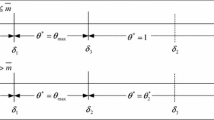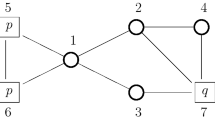Abstract
This paper focuses on sharing the costs and revenues of maintaining a public network communication structure. Revenues are assumed to be bilateral and communication links are publicly available but costly. It is assumed that agents are located at the vertices of an undirected graph in which the edges represent all possible communication links. We take the approach from cooperative game theory and focus on the corresponding network game in coalitional form which relates any coalition of agents to its highest possible net benefit, i.e., the net benefit corresponding to an optimal operative network. Although finding an optimal network in general is a difficult problem, it is shown that corresponding network games are (totally) balanced. In the proof of this result a specific relaxation, duality and techniques of linear production games with committee control play a role. Sufficient conditions for convexity of network games are derived. Possible extensions of the model and its results are discussed.
Similar content being viewed by others
References
Claus, A. and D. Kleitman. (1973). “Cost Allocation for a Spanning Tree.” Networks 3, 289–304.
Curiel, I., J. Derks, and S. Tijs. (1989). “On BalancedGames and Games with Committee Control.” OR Spektrum 11, 83–88.
Granot, D. and G. Huberman. (1981). “Minimum Cost Spanning Tree Games.” Mathematical Programming 21, 1–18.
Ichiishi, T. (1981). “Super-Modularity: Applications to Convex Games and the Greedy Algorithm for LP.” Journal of Economic Theory 25, 283–286.
Maschler, M., B. Peleg, and L. Shapley. (1972). “The Kernel and Bargaining Set of Convex Games.” InternationalJournal of Game Theory 2, 73–93.
Myerson, R. (1977). “Graphs and Cooperation in Games.” Mathematics of Operations Research 2, 225–229.
Owen, G. (1975). “On the Core of Linear Production Games.” Mathematical Programming 9, 358–370.
Shapley, L. (1971). “Cores of Convex Games.” InternationalJournal of Game Theory 1, 11–26.
Sharkey, W. (1991). “Network Models in Economics.” In J. Moder and S. Elmaghraby (eds.), The Handbook of Operations Research and Management Science, New York, Van Nostrand Reinold.
Slikker, M. and A. v.d. Nouweland. (2001). Social and Economic Networks in Cooperative Game Theory. Boston: Kluwer Academic Publishers.
Slikker, M. and A. v.d. Nouweland. (2000). “Network Formation with Costs for Establishing Links.” Review of Economic Design 5, 333–362.
Author information
Authors and Affiliations
Additional information
The research of Jeroen Suijs has been made possible by a fellowship of the Royal Netherlands Academy of Arts and Sciences.
Rights and permissions
About this article
Cite this article
Suijs, J., Borm, P., Hamers, H. et al. Communication and Cooperation in Public Network Situations. Ann Oper Res 137, 117–140 (2005). https://doi.org/10.1007/s10479-005-2249-4
Issue Date:
DOI: https://doi.org/10.1007/s10479-005-2249-4




